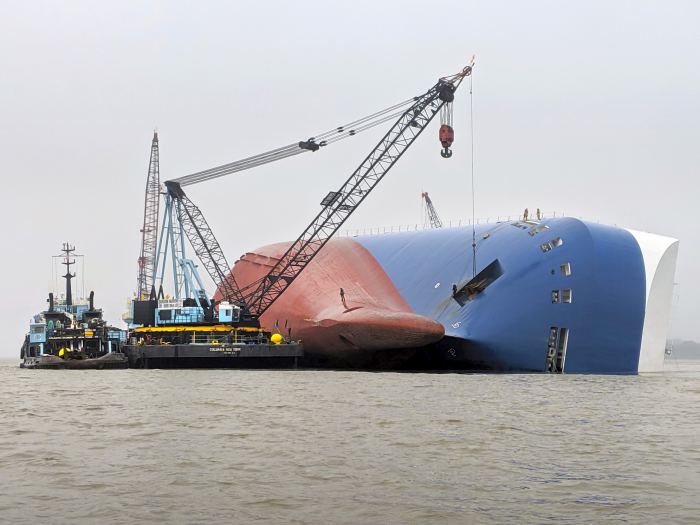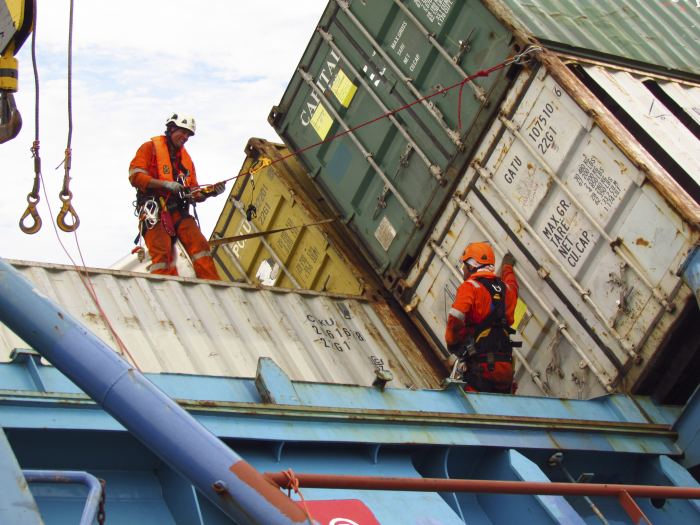Boskalis subsidiary SMIT Salvage regularly makes the international news headlines with its spectacular operations to rescue ships in distress, including their cargoes and sometimes even their crews. With their extraordinary endeavors, the salvage teams also frequently avert major environmental disasters by preventing hazardous substances from leaking into the sea or washing up on a beach. As Global Salvage Operations Manager Thijs van der Jagt explains, “protection of ships and their cargoes and care for the environment are at the heart of our salvage work.”
As Global Salvage Operations Manager Thijs supervises SMIT Salvage’s global marine salvage, wreck removal and rescue activities. “My job entails guaranteeing that we provide the highest possible standard of service and safety wherever in the world it is needed, that we have the right people on the right place, and that they have the equipment they need to perform their work effectively. And ensuring that we devote the utmost care and attention to the needs of the client,” he says. “We have recently devoted a great deal of time and energy to expanding the global reach of our organization. Our operational centers in Cape Town, Houston, Singapore and Vlaardingen used to have a relatively strong regional orientation, but nowadays we focus more on training and exposing members of our teams to salvage operations worldwide. Since our area of operations covers a wide range of countries and cultures, our salvage specialists must all be deployable interchangeably anywhere in the world.”

Global Salvage Operations Manager Thijs van der Jagt
Core business
Could you briefly describe SMIT Salvage’s most important tasks?
“Our principal activity is rescuing ships in distress as well as their cargoes. Our most important task is to prevent impairment of the value of the client’s asset. We do everything in our power to prevent a ship from sinking or the cargo being lost. The value of the salvaged assets partly determines our salvage fee. Occasionally, we also have to rescue a vessel’s crew members. Normally, the coastguard is responsible for rescuing the crew and the salvage company for saving the ship and the cargo. However we naturally spring into action if there is no coastguard vessel on the scene or if crew members are difficult to reach. Our expertise and equipment are regularly called upon when people need to be rescued from a ship. For example, we saved the lives of four trapped crew members during the rescue of the Golden Ray car carrier in the United States. Another core activity is wreck removal, which is more project-driven. We might be asked to remove a sunken ship from the seabed, for example. Some renowned wreck removals we have completed in the past are the nuclear submarine Kursk, the ferry Herald of Free Enterprise, the cargo ship Tricolor and the car carrier Baltic Ace.”

The capsized Golden Ray from which the SMIT Salvage crew rescued four trapped crew members
Potential environmental threats
Are environmental aspects always a factor in salvage operations?
“Absolutely. In practically every case, they are. I want to start by saying that environmental safety has received enormous attention in the design and construction of ships in the last few decades. New tankers all have double hulls, for example. But as soon as a ship is involved in an extraordinary situation, such as a collision or a fire on board, it has to be assumed, almost automatically, that there is a potential environmental hazard. After all, even if the vessel is not carrying oil products, it will always have fuel on board. Accordingly, with this type of incident we will almost always have to provide environmental care to prevent or mitigate any harm to the environment. That sometimes means that we remove oil from a stranded ship even though, structurally speaking, the oil is still stored perfectly safely. As a salvage company we will naturally always do what the client requests, provided it is in line with all the guidelines and rules and the agreements that have been made. Indeed, we have often played an important part in preventing an environmental disaster. A recent example is the salvage of the Front Altair, a ship carrying naphtha that was in flames following an attack in the Gulf of Oman. Others include the rescue of the Blue Star, a chemical tanker which was stranded off the coast of Spain; the refloating of the oil platform Transocean Winner, which had run aground off the Scottish coast; and the salvage of the capsized car carrier Golden Ray. Every one of these incidents could have led to a major environmental disaster.”
WE DO EVERYTHING IN OUR POWER TO PREVENT A SHIP FROM SINKING OR THE CARGO BEING LOST.
Does the media publicity for spectacular salvage operations attract people to your profession?
“To us, salvaging vessels is simply our day-to-day job, just as a doctor saves lives for a living. Preventing an environmental disaster might seem like a heroic act to an outsider, but it’s just another day at the office for us. Of course, we take pride in a successful operation and do appreciate the importance of some rescue missions. But the simple fact is that if there is a ship in distress and oil and other hazardous substances have to be removed from it we have the specialists, the procedures and the versatile equipment to do the job. We just get on with it. Of course the work also demands creativity, professional expertise, perseverance and the ability to improvise, but we generally prefer to play down those aspects. That is usually also out of respect for the client’s interests. Among ourselves, though, we like to joke that one thing we can’t complain about is a lack of excitement – there is never a dull moment.”
Environmental care
You mentioned environmental care. What do you mean by that?
“For a salvage company, environmental care means taking responsibility for a range of activities connected with the safe handling and transport, and sometimes further treatment, of hazardous substances. When we remove oil from a wreck we have to pump it onto other ships and then later, perhaps have to pump it back again. Occasionally, we transfer the oil to shore to be stored in tankers or containers. In a recent project we pumped the oil from a ship into small containers, which we then removed by helicopter. We sometimes use special oil screens to ensure that the oil does not enter the water or end up on a beach. We always bring in our own salvage crews and our own specialist equipment for these types of assignment. In some cases we charter tankers or tugs from local companies. That capacity to rely on a very extensive global network of shipping agencies and suppliers is an important factor in our success. Environmental care also extends to coordinating and supervising the responsible dismantling and recycling of salvaged ships if the client requests it. We can also manage the follow-up to a salvage operation at the client’s request. For example, for one client we carried out the enormous task of removing and processing the burnt remains of the ultra large container vessel Maersk Honam in Dubai.”
Maersk Honam
Can you describe what these operations involved?
“Let’s start with the offloading after the salvage of the Maersk Honam. Almost two years ago we extinguished an immense fire on board this enormous container ship in the Arabian Sea and salvaged the vessel. Following this operation we signed what is known as a caretaking contract. Under that contract we provided trim and ballast assistance in the unloading of undamaged containers from the stern of the vessel in the Jebel Ali port in Dubai. But our most important task was to empty the three completely burnt-out holds in the forward part of the ship. We removed all the burnt and highly contaminated residues and stored these on a specially designed yard ashore. An extremely difficult job, because in the 24-meter-deep holds there was a complete chaos of debris, burnt material and a kind of chemical soup made of heavily contaminated, toxic liquid. There are no standard solutions for extreme operations of this nature. We devised a unique approach that involved mobilizing two jack-up barges and positioning them alongside the wreck. Using spider grabs and excavators with pressurized cabs, we removed 27,000 tons of burnt and charred remains. But there was also a lot of manual work involved and the team members had to wear protective clothing and pressure suits. Because of the tremendous heat in the holds they could only work with cooling vests.”
THE JOB TOOK ALMOST TWO MONTHS, WORKING TWELVE HOURS A DAY AND SEVEN DAYS A WEEK.
Yantian Express
Didn’t you also carry out a similar operation in the Bahamas last year?
“Indeed. We performed this assignment as a follow-up to an operation to extinguish a fire on board the container ship Yantian Express. We were called on to help unload 662 containers from the fire-damaged ship as it lay in Freeport. We deployed a team of more than twenty for an intensive operation to remove the burnt cargo from the forward holds and dispose of it in an environmentally friendly manner. The fire and the extinguishing water had created an enormous mess in the bow of the ship. Many of the containers were badly damaged and often the contents had become wet. Because of the water damage we had to burn through the roof of numerous containers with a grinder and then remove the cargo manually. We established a large site in the port and hired a quay crane and other equipment. We knew from the ship’s manifest which containers needed to be handled with special care, for example because they contained a hazardous substance. To address the risk of possible pollution we took special precautions on the site by installing so-called drip trays, which are large tubs consisting of sand boxes covered with a thick layer of impermeable canvas. The containers could leak into them and we could then pump out and treat the contaminated water. In other words, we designed a provisional waste collection facility. Some of the cargo had to be transferred to empty containers by hand. Because of the heat in the holds we started work early in the morning. The job took almost two months, working twelve hours a day and seven days a week. Although we are salvage specialists and have more experience with this sort of work than the employees of the container terminal who are not trained for this type of work, even for our team it was a tough assignment.”

